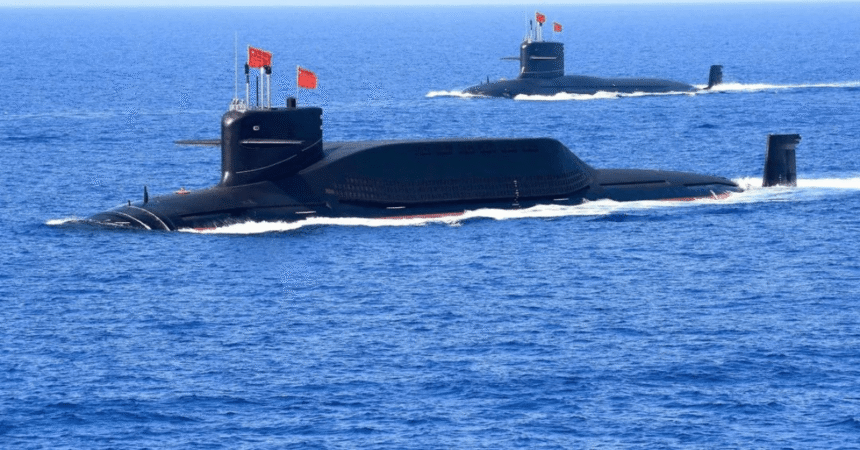Recent reports have revealed that a significant incident involving China’s first Zhou-class nuclear-powered attack submarine has occurred, with the vessel reportedly sinking at a shipyard during its construction. This incident, which is believed to have taken place between May and June 2024, raises pressing concerns regarding the state of China’s naval capabilities and the broader geopolitical implications of such a setback.
Overview of the Incident
According to senior U.S. defense officials, the submarine sank at the Shuangliu shipyard along the Yangtze River. Satellite imagery analysis has indicated that cranes are currently stationed at the site, suggesting that recovery operations may be in progress. However, the specific details surrounding the submarine’s condition—such as whether it was operational or contained nuclear fuel at the time of sinking—remain ambiguous. Importantly, there have been no reported radiation leaks since the incident, which provides some reassurance amid the uncertainty.
crossorigin=”anonymous”>The Zhou-Class Submarine
The Zhou-class submarine represents a significant advancement in China’s efforts to modernize its naval fleet, which is now regarded as the largest in the world. This class is expected to enhance China’s ability to conduct anti-submarine warfare and other strategic operations in contested waters, notably the South China Sea. The design aims for stealth and efficiency, which are critical for modern naval engagements.
The development of the Zhou-class submarine is part of a broader strategy by China to expand its military capabilities and assert its influence in regional disputes. The loss of this submarine during construction is not only a setback for its military aspirations but also highlights the inherent risks involved in rapid military expansion.
crossorigin=”anonymous”>Implications for China’s Naval Expansion
- Setback in Naval Capabilities: The loss of a submarine under construction is a significant blow for Beijing as it strives to expand its naval capabilities amidst heightened tensions in the region. The Zhou-class submarine was poised to be a vital asset in China’s strategic maritime initiatives.
- Geopolitical Tensions: The sinking occurs at a time when China is aggressively pursuing military modernization, including the development of new naval vessels. This expansion has raised alarms in neighboring countries, prompting the United States to increase its military presence in the region to counterbalance China’s assertive posture.
- Regional Reactions: Nations such as the Philippines, Vietnam, and Taiwan, which are embroiled in territorial disputes with China, may view this incident as a sign of vulnerability within China’s military operations. Such perceptions can influence regional security strategies and alliances, potentially altering the balance of power in the South China Sea.
The South China Sea Context
The South China Sea is a critical region for international trade and is characterized by overlapping territorial claims from multiple countries, including Brunei, Malaysia, the Philippines, Taiwan, and Vietnam. The stakes in this region are high, as it not only serves as a significant maritime route but is also believed to hold vast underwater resources.
China’s assertive stance in the South China Sea has prompted responses from the U.S. and its allies, who conduct regular naval operations to ensure freedom of navigation. The sinking of the Zhou-class submarine could be perceived as a potential opening for the U.S. to reinforce its presence, emphasizing its commitment to countering China’s assertiveness.
crossorigin=”anonymous”>U.S. Military and Strategic Response
In light of this incident, the United States is likely to continue reinforcing its alliances in the Asia-Pacific region. Recent developments, including a rare intercontinental ballistic missile launch by China, highlight the escalating military tensions in the area. The U.S. Navy has been active in conducting operations to ensure freedom of navigation, which remains a cornerstone of its strategy in countering China’s influence.
- Strengthening Alliances: The U.S. is likely to enhance cooperation with regional allies, including Japan, South Korea, Australia, and India, to bolster collective security efforts. This could involve increased joint military exercises, intelligence sharing, and collaborative defense initiatives.
- Increased Military Presence: The U.S. may consider augmenting its naval presence in the region in response to China’s military activities. Such a move would demonstrate U.S. commitment to its allies and partners, reinforcing deterrence against potential Chinese aggression.
Satellite Imagery and Evidence
Satellite images obtained from Planet Labs PBC have played a crucial role in uncovering the details surrounding the incident. Initial images revealed the Zhou-class submarine docked at the shipyard before the sinking. A subsequent image from June 15 indicated that the submarine was either partially or fully submerged, with cranes and rescue equipment surrounding the site.
The deployment of booms around the vessel signifies efforts to contain any potential environmental impact from the sinking, reflecting the military’s awareness of the need to manage the incident responsibly. The response demonstrates a level of preparedness that is essential when dealing with the complexities of naval construction and potential environmental hazards.
crossorigin=”anonymous”>Expert Analysis and Commentary
Military analysts have provided insights into the implications of this incident. Thomas Shugart, a former U.S. Navy submariner and an analyst at the Center for a New American Security, observed that such incidents, while unfortunate, are not uncommon during the construction of complex naval vessels. However, losing a nuclear submarine during construction is a notable event that has ramifications for China’s military ambitions.
- Challenges of Rapid Expansion: Shugart emphasized that this setback underscores the complexities and risks associated with rapid military expansion. The challenges faced by China’s shipbuilding industry may affect not only the timeline for the Zhou-class submarines but also other naval projects in development.
- Strategic Reevaluation: The incident could prompt a strategic reevaluation within the Chinese military regarding its shipbuilding practices and operational protocols. Lessons learned from this incident may inform future projects and potentially lead to increased scrutiny and quality control measures during construction.
Environmental Concerns
One of the critical aspects of this incident involves potential environmental implications. While no radiation leaks have been reported, the sinking of a nuclear submarine raises concerns about potential contamination and ecological impact.
- Containment Measures: The deployment of booms around the submarine indicates proactive measures to prevent any leakage of oil or hazardous materials. This response is essential in minimizing environmental damage and addressing public concerns about safety.
- Public Perception and Trust: The handling of this incident will play a significant role in shaping public perception of China’s military and industrial capabilities. Transparency in the recovery efforts and environmental management will be crucial in maintaining trust among the Chinese populace and the international community.
Future Prospects for China’s Naval Strategy
As China grapples with the implications of this incident, its broader naval strategy may evolve in response to emerging challenges and opportunities.
- Investment in Research and Development: China may choose to allocate additional resources toward research and development in naval technologies to enhance the reliability and safety of its vessels. This investment could focus on improving construction techniques and exploring advanced materials that minimize risks during the building process.
- International Collaboration: In light of the challenges faced in domestic shipbuilding, China might explore opportunities for international collaboration in naval technologies. Partnering with other countries could facilitate knowledge exchange and access to advanced technologies that enhance its naval capabilities.
- Focus on Sustainability: The incident may prompt a reevaluation of China’s approach to military modernization, emphasizing sustainability and environmental responsibility. As global concerns about climate change and ecological impacts grow, integrating environmentally friendly practices into military operations could become a priority.
The sinking of the Zhou-class submarine during construction is a notable event that carries significant implications for China’s naval ambitions and regional dynamics. As Beijing continues to pursue an aggressive military modernization strategy, setbacks such as this may prompt reevaluations of its approach and capabilities.
The incident highlights the intricate balance of power in the Asia-Pacific region and the importance of strategic responses from the United States and its allies. As the situation develops, monitoring the recovery efforts and China’s subsequent actions will be crucial in understanding the broader implications for regional stability and security.
In the coming months, it will be essential to observe how China addresses this setback, both in terms of recovery operations and broader strategic shifts. The outcome will not only influence China’s military capabilities but also impact the geopolitical landscape in one of the world’s most contested regions.
#China #ZhouClass #NuclearSubmarine #SouthChinaSea #Geopolitics #USMilitary #NavalExpansion







